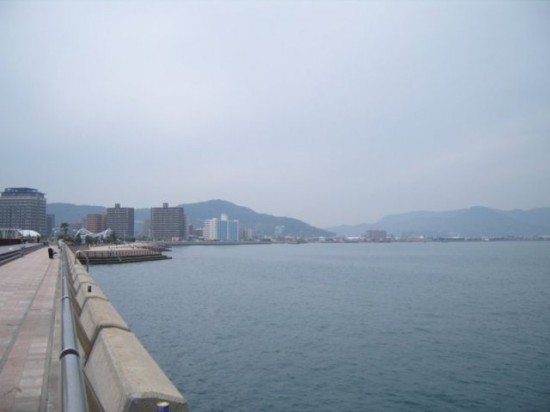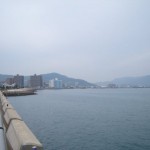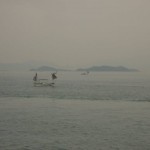My first full day in Takamatsu (that is May 19th, 2009) started very early, at 4AM. Usually, when I travel eastwards, if I didn’t do anything special to affect jetlag, the result is that I will go to bed very late and get up very late too for a few days (and I assume it’s the same for pretty much everyone, isn’t it?). So, why exactly did I wake up that early on that day? I’m afraid we will never know.
Of course, I tried to fall back to sleep and of course I didn’t manage to do so before 7am. I finally got up around 9am when 康代 woke up me. She had slept for most of the trip and most of the night. She was full of energy and ready to go. Not me, even though you know how jetlag works, one minute you’re wide awake and the following one, you’re falling asleep.
This first Japanese morning was mostly spent walking by the seaside and visiting Takamatsu Sunport. Roughly the same spots as the previous night, with one major difference, this time I could see what was in the distance (a small distance actually) whether it’d be islands or boats.

I will avoid the topic of my first breakfast in Japan as much as possible; it was coffee and donuts. Not very Japanese, I know, but it was the closest thing from the hotel and we didn’t have much time to look for something else.
Towards the end of the morning, I finally met my soon to be parents-in-law, we “moved in” with them and went for lunch in a shopping mall nearby (that’s Aeon for those who know Takamatsu).
First Lunch in Japan
The most interesting thing during this first lunch in Japan was not the food itself, I was already quite familiar with Japanese restaurant cuisine (I had Tonkatsu and Udon, I was hungry), but to discover eating habits in Japan; for example the fact that you’re supposed to eat your noodles slurping them quite loudly. A custom that is quite disconcerting for a Westerner who has been told since his earliest days to not make any noise when eating. It was odd to see and hear all of those very respectable and polite people making as much noise as a drunk homeless dude when eating their noodles.
Ah, cultural differences, you never cease to fascinate me.
It became even more disconcerting when I tried to make the same noise in an effort to show appreciation for Japanese culture as well as an attempt to blend in. No sound came out. On the other hand, I almost choked to death when an Udon noodle got stuck in the back of my throat. I decided that for the rest of the trip, I wouldn’t care if Japanese people got very upset at me because I didn’t make a single sound eating my noodles. I’d rather be impolite and alive than polite and dead, killed by a noodle. In the end, I realized that Japanese people didn’t really care how many decibels came out of my mouth when eating Udon, so everybody was happy.
Another habit really bothered me though. The fact that in Japan, it’s ok to smoke in restaurants. Sure, we were far from what the situation used to be in bars in Europe before the smoking ban laws were passed. However, I really find the act of smoking disgusting when food is involved, and at least in France, I could tell off annoying people who smoked near food. Not in Japan as not only I couldn’t speak to them, but worse, they were doing nothing wrong according to the local rules and habits. The strangest thing was that restaurants seem to be the only public space where people smoked. They seemed very rare anywhere else. Even more strangely, it is illegal to smoke in certain streets, in open air, where smoke won’t bother anyone.
The country where lettuces and cookies sing to you so that you buy them
After lunch, 康代’s mom had some groceries to do, so we went with her. Most people, when they travel abroad, don’t go to supermarkets. I think it’s a shame. Supermarkets, grocery stores, whatever you call them, are one of the most interesting places to visit when you travel abroad. They are one of the main keys to learn about everyday life in the visited country. And if you think that supermarkets in rich countries are all the same, think again. Believe or not, but when I went to live in the US, grocery stores stayed the strangest, most different and least comprehensible part of the country for a very long time.
And what did I notice and learn for my first trip to a Japanese supermarket?
First, I was surprised to not find it that strange after all. It looked like a strange hybrid between a French and an American grocery store. I guess that in a country like Japan where everything is so unusual and strange, there are hundreds of things unsettling at every corner. As a consequence, supermarkets don’t seem that strange after all.
However, here are a few observations that I made during that first visit:
– In Japanese supermarkets, items and products talk to you! Ok, they don’t actually talk. It just seems that every grocery store has dozens of hidden CD players, loudspeakers, TV screens; anything that generates sound or images, and from which constantly comes out a flow of songs, commercial jingles, and other announcements. I even saw a store employee, in an aisle, record a special announcement for some special discount for that one product next to which he was standing. In consequence, there’s a permanent cacophony in the store to the point that I wonder how one doesn’t get headaches every time they shop and how people working in grocery stores don’t become crazy (maybe they do).
– If you have spent time in foreign supermarkets, you know that each country tends to have a dominant product. By that I mean a product that will occupy one or even several aisles, while they’ll be more or less rare in other countries. In France, it is cheese and yogurts. In the US, cereal, sodas, and junk food have taken over supermarkets. In Japan, no surprise, it was fish of course.
Not being a fish specialist, even less a Japanese fish specialist, I am not going to get into details, but know that it goes from fish that is already prepared and ready to eat on the spot to fish that was alive a few minutes ago, from whole fish to fish that is already cut in slices for sashimi. Of course, there isn’t just a handful of available species but several dozens, most of them, I had never heard of before (or I had, I just don’t know how they look). Add seafood to that and you get the picture.
– The way Japanese people use English never ceases to both amuse me and make me wonder. I briefly talked about it a couple of days ago when talking about my arrival in Takamatsu, but it was flagrant in the grocery store. To my surprise, in certain parts of the store – usually the parts against the walls – there were some big signs in English: “Meat”, “Fish”, “Vegetables”! If you ask the reason why those big signs to a Japanese person, the answer you will most likely get is that those signs are there in order to help foreigners who come shopping. Indeed. If a foreigner is in an aisle full of tomatoes, cucumbers and lettuces, they will be so happy and relieved to see a big “Vegetables” above as they were so confused as to where they were a few seconds earlier, unable to recognize any of the products.
I keep on wondering whether this habit of translating obvious things and not what is not obvious comes from a genuine (but misplaced) intent to help foreigners or if those unnecessary translations serve a completely different purpose. Making Japanese people convince themselves that they’re more open to the rest of the world than they really are.
This is a topic that really interests me, and I shall investigate further.
(Since I wrote those lines two years ago, I did investigate more. My current theory is that it’s a little bit of both)
– Customers are plenty in the middle of the afternoon, and are almost all female, with the notable exception of a few retired old men (who live alone?) I knew that most Japanese women, even nowadays, were stay-at-home moms, but it never really hit me before that day. What was just a statistics I had heard about became a reality in that store.
The day is far from over and the rest is coming soon…
Discover more from Setouchi Explorer
Subscribe to get the latest posts sent to your email.



Supermarkets visit is an enjoyable part of my trip to Japan too! The easiest way to get a glimpse of normal Japan as opposed to the touristy places where all the tour groups go to. 🙂
Will be waiting for the next installments! Hope it’s soon! 🙂
Yes, I really do that in every country I go to, it’s always very instructive.
I”ll try to finish the tale of that trip before leaving for the next one (ok, who am I fooling here? I know I won’t have time, but I’ll do my best.) 😉
I love visiting supermarkets in other countries too. I think you can learn a lot about a country from it’s supermarkets and bars.
I never thought about bars (maybe because I don’t like French bars much and hang out in British pubs and North American bars even in France), but you’re right.
Got here through Lina’s blog…
Welcome to Takamatsu…
It is interesting to read your account about Takamatsu and Japan…
I agree with your comment on smoking in restaurants in Japan… I find it disgusting too…
Enjoy your stay here…
Hey,
Actually I know you. I’ve been reading your blog for a few weeks (I guess I found it through Lina’s too).
Thanks for stopping by and commenting.
Don’t bet mistaken though, this story I’m telling now is about my first visit of Takamatsu in 2009, and I don’t live in Takamatsu. I just hope to do it one day. 🙂
I am laughing upon reading your reply… good to hear that you have been reading my post for a while… Takamatsu is a lovely place to stay, from my experience…
Yes, I really like Takamatsu. I think that I instantly loved the area that first time I went.